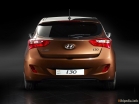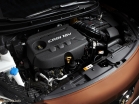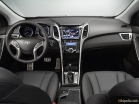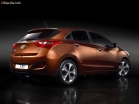Hyundai I30 test drive since 2010 hatchback
Hyundai i30: Are we familiar?
Bringing the Hyundai I30 hatchback on the Russian market, the South Korean company was counting on a serious help to the rest of the model range. Indeed, in its short history, the Hyundai i30 has already become confused on Russian roads.According to the official information of the Russian representative office, according to the results of January 2010, I30 took third place after the bestsellers of the Hyundai Tucson and Getz, while overtaking the popular Elantra.
The appearance of AI30 is the brainchild of the European design center of the company. Yes, and it was created in accordance with the preferences of buyers from the Old World. The dynamic appearance is distinguished by a typical with a slanting optics, muscular lateral stamping and red triangles of lanterns.
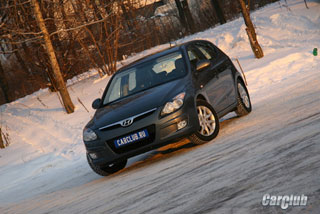
The Khundaevites developed i30 specifically for the European market. The hatchback took root in Russia: in January 2010, he lost to sales to the bestsellers of the modeling range of Korean manufacturer - the Getz hatchback and the Tucson crossover.
There is no sports aggression in the exterior, which is distinguished by the one -platform Kia Cee`d. By the way, it is with KIA that our experimental divides both the base and the technical filling. The only difference is that the Hyundai i30 is supplied to the Russian market only with 1.4- and 1.6-liter motors in a five-door hatchback, while CEE`D is presented in three body variants, two of which (three-door hatch Pro_cee `D and the Cee`d_SW station wagon can be equipped with a 2.0-liter gasoline engine with a capacity of 143 hp.
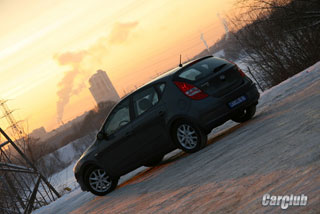
Upon closer examination, the similarity of the one -platform Kia Cee`d and Hyundai i30 is obvious. It is only necessary to drop the details.
The interior of the Hyundai i30 is a typical Korean. Simple plastic, poisonous instrument lighting, rough skin on the steering wheel adjacent to good ergonomics. The landing is high. Leather chairs are characterized by a good profile and good lateral support. Places from behind a little tall passengers will clash the back of the front seats with the knees.
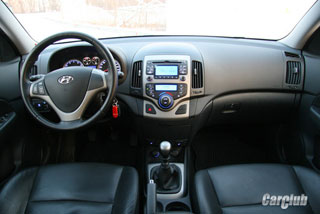
The interior of the i30 is woven from simple plastic, but assembly and ergonomics at a height. In the list of Style top -end options, there is even a leather interior decoration. Sidd’s similarity with a sid is unequivocally reminiscent of vertical deflectors of blowing and an oasis of keys on the central console.
Similarly, a sida in the center of the front panel I30 houses an oasis of keys and steeple, which are responsible for controlling the audio system and climate installation. The audio system knows how to connect with external devices via AUX, as well as read information from USB flash drives.
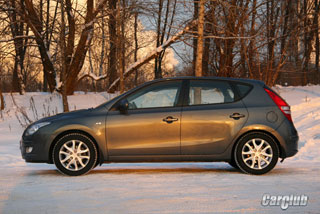
The dynamic silhouette of the Korean with a solid optics, muscular stamping on the sides and large rear lights is a win -win option.
The volume of the trunk is far from the leader in the class of only 340 liters. Having folded the rear seat, separated in a ratio of 60:40, its volume can be increased to 1250 liters.
For the test we got the most packed version of Style with a 1.6-liter engine with a capacity of 122 hp. and a five -speed manual gearbox. As an alternative to mechanics, an outdated 4-band machine is already offered by the mechanics, for which you need to pay as much as 50 thousand rubles.
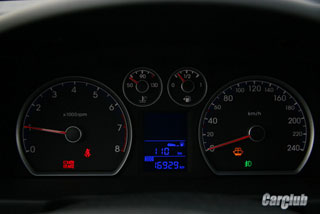
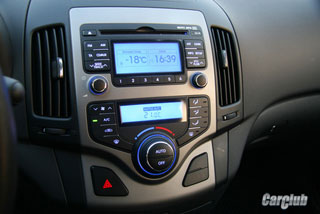
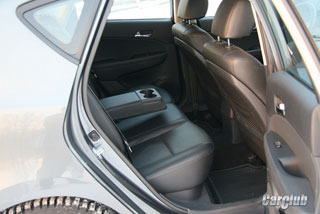
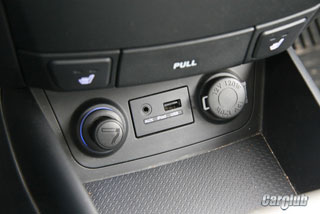
A simple instrument panel is good for good information. The audio system understands the MP3 format, and also eats USB flash drives and knows how to connect with external devices on the AUX channel. You can’t call the rear sofa cramped, but it will be uncomfortable for tall passengers there.
The motor surprisingly cheerfully accelerates the hatchback up to 120 km/h, after which the rate of acceleration slows down significantly. Due to the too sensitive, the gas pedal and completely uninformative adhesion will move without slipping on studded tires is almost impossible. In addition, the cotton lever of the transmission does not differ in the clarity of moves and good selectivity.
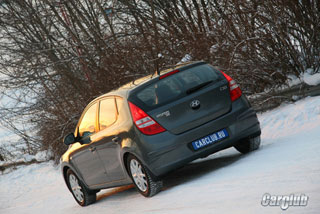
In the Russian market, the cost of the Hyundai i30 in far from empty configuration starts from 533,900 rubles.
Despite this, thanks to a well -chosen gear rates in the I30 box, he demonstrated a rather prominent character. The main thing is not to lower the tachometer arrow below 3 thousand revolutions. The hatchback obediently follows the turn of the steering wheel, which is distinguished by a clear zero and good informativeness. I remember that a similar character was pleasantly surprised by the baby Hyundai I20 during a comparative test with VW Polo.
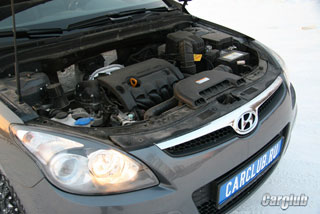
The 1.6-liter motor comes to life after 3 thousand and is awake until the cut-off. The gear rates in the 5-speed manual transmission are successfully selected. But the impression spoils the completely non -informative clutch and a cotton lever of transmission. In addition, the 6th gear is clearly not enough to save fuel with a manual box.
Trying to please the demanding Europeans, the victim of good controllability and minimum rolls in corners brought smoothness and comfort. Even on soft winter tires on the Hyundai body, all fossa and bumps are transmitted with details. Coldings are more accompanied by dull blows. Here and the breakdown is not far.
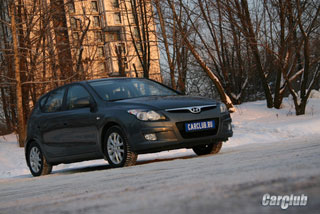
Already in the Hyundai i30 database is equipped with 6 safety stumps, ABS and air conditioning.
The brakes are good: an understandable pedal force is combined with good efficiency, and in the case of blocking the wheels, ABS correctly enters into business. In addition, there is also a stabilization system in the top configuration, which immediately comes into effect if the car has begun side sliding.
In Russia, the cost of the Hyundai i30 with a 1.4-liter engine and manual transmission begins with 533,900 rubles. However, already in the basic performance of Classic there is everything you need, including 6 airbags, heating of the seats, air conditioning, ABS, an audio system with control on the steering wheel and an electric package.
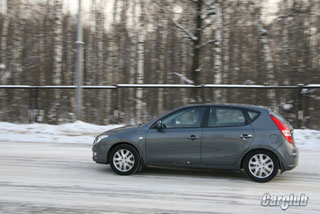
On the road, the Hyundai i30 is daring. Sensitive gas pedal, hard suspension and clear steering allow the Korean hatchback to fight on equal terms with more eminent competitors.
Comfort execution offers the steering wheel adjustment in 2 planes, 2 level heating of the front seats, rear electric windows, climate control, armrest, cooled glove, on-board computer, rain sensor, steering wheel and gearbox leather with skin, as well as foggy and alloy Disks. For this version, 609,900 rubles will have to be laid out. The surcharge for a 1.6-liter engine will eat another 30 thousand rubles.
Style top equipment is offered only with a 1.6 -liter engine and is characterized by the presence of an ESP stabilization system and the leather decoration of the cabin. The cost of such a version is 669,900 rubles. In addition, at present, all modifications of the Hyundai i30 are distributed, which, depending on the level of equipment, is from 30 to 60 thousand rubles.
Ruslan Galimov.
pros
Good handling
Long motor
Attractive price
Minuses
Non -informative clutch
Cotton lever of the manual transmission
Weak sound insulation
The price of the tested car is 669 900 rubles
Complete the test of the tested car
Driver safety pillow
Front passenger airbag
Front side pillows
Safety curtains
Active front head restraints
Adjustment of the front seat belts in height
Front seat belts
ABS + EBD
ESP
Roll adjustment in height
Settlement steering wheel adjustment
Adjustment of the driver's seat in height
2-level heating of the front seats
Electric power steering
Electric windows before.+ Ass.
Electric drive of mirrors + electricalwork
Heating of mirrors
Signaling
climate control
The armrest of the driver
Cooling glove box
On-board computer
Heating of the wiper rest zone
Light sensor
Rain sensor
USB+AUX connectors for connecting external devices
Radio (radio+ CD+ mp3+ 6 Dean)
Radia control unit on the steering wheel
Rolling the steering wheel and handle of the gearbox skin
Leather salon
Fog lights
Cast discs 16 with rubber 205/55
Spare wheel - DOCACE
Specifications
Body
Hatchback body type
The number of places 5
Trunk volume, l 340/1250
Equipped mass, kg 1193
Full mass, kg 1720
Length, mm 4245
Width, mm 1775
Height, mm 1480
Wheel base, mm 2650
Road clearance, mm ---
Engine
Basin type with distributed fuel injection
The location in front is transversely
Location and number of cylinders 4 in a row
Working volume, cm 1591
Cylinder diameter/piston stroke, mm 77.0 x 85.44
The degree of compression is 10.5
The number of valves per cylinder 4
Maximum power, L.S./rpm 122/6200
Maximum torque, Nm/rpm 154/4200
Transmission
Mechanical gearbox 5-speed
Front drive
The front suspension is independent, such as McPherson with a reptile stability stabilizer
The rear suspension is independent, multi -link with a reptile stabilizer
Front brakes Disco ventilated
The rear brakes are disk
Tires 205/55 R16
Dynamics
Maximum speed, km/h 192
Acceleration time 0-100 km/h, from 11.0
Fuel consumption, l/100 km
city cycle 8.0
country cycle 5.2
mixed cycle 6.2
Fuel tank capacity, l 53
Fuel AI-95 gasoline
A source: Carclub.ru

